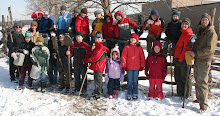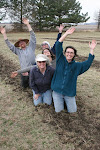
Gillian’s log for week of October 25-31, 2009:
Good evening!
The garden was a great success this year and has been put to bed for the winter. I wanted to let you know the greens are still growing, so please pick them and eat them freely!
I planted rye and red clover for the cover crop, so next spring please plow those into the soils and plant transplants directly into it. The clover will add nitrogen to the soil and the rye, when plowed into the soil, will stop seeds from germinating, so transplants get a jump start on the weeds! I did not, however, plant cover crops in the rows with the greens (spinach, arugula, and kale), so after they're done you're welcome to plant the cover crops, or just let them go until the spring (letting the greens be the cover crops). The onion row also doesn't have a cover crop because it had grown over and couldn’t be weeded; it should be okay to leave for the winter and just till it along with the rest of the rows in the spring.
The garlic has been planted and mulched on the 3rd row from the north. It should be ready around July next year!
--------------------------------------------------------------------------------------
2009 Okanis Garden Planting Plan
Varieties:
50 Basil (Opal and Italian Large Leaf)
Peppers (25 Gourmet Green/Orange; 25 Snapper Green/Red)
Cherry Tomatoes (25 Yellow Mini; 25 Sun Gold)
Onions (Candy Yellow, Mars Red, Superstar White)
Rows, from north to south:
(Russian Mammoth Sunflowers)
- Snap bush beans - Painted Corn/Yard Long Pole Beans/birdhouse gourds
(+other unproductive crops of honey dew melon, eggplant, lemon cucumber)
- Yukon Gold Potatoes (1st crop) - Kale (2nd crop)
- Rose Finn Apple Potatoes (1st crop) - Garlic (2nd crop, planted October, 2009)
[Outdoor classroom space, on sod]
- Summer Savory Herbs - Yard Long Pole Beans - Trellised Japanese Black Trifele Heirloom Tomatoes
- Culinary Sage Herbs - Trellised Yellow Bell Plum Heirloom Tomatoes - Trellised Valencia Heirloom Tomatoes - Trellised Japanese Black Trifele Heirloom Tomatoes (about 100 plants)
- Mexican Tarragon Herbs - Trellised Cherry Tomatoes
- Culinary Sage Herbs - Pickling Cucumbers (1st crop) - Spinach (2nd crop)
[Outdoor classroom space, on sod]
- Arugula (2nd crop) - King Richard Leeks - Onions (3 kinds)
- Kale (2nd crop) - Arugula (2nd crop) - Basil - Sweet Peppers
- Cosmos and Zinnias
(+unproductive Yellow Crookneck Squash)
--------------------------------------------------------------------------------------
A suggested plan for next growing season based on organic crop rotation practices:
Rows starting from the South end (neared the parking lot)-
Tomatoes
Tomatoes
Potatoes
Potatoes
Flowers
Basil/Peppers
Onions/Leeks
Garlic (already planted in 2/3rds)/Beans
Cucumbers/Squash/Beans
Cherry Tomatoes
It was a wonderful couple of months and I hope the garden flourishes next year!
---
Late in October, as Gillian and Laurie stood in the shed doorway, watching a light rain begin to fall on the cover crops, Gillian proclaimed, “What a sweet little garden!”



















